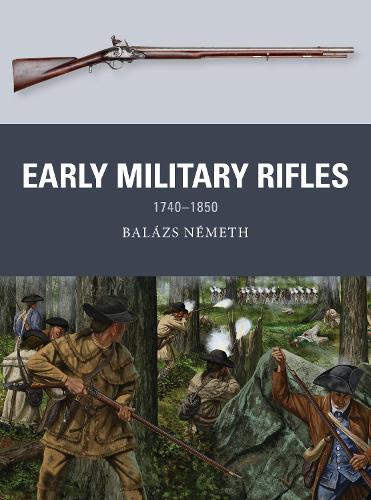
Early Military Rifles: 17401850
(Paperback)
Publishing Details
Early Military Rifles: 17401850
By (Author) Balzs Nmeth
Illustrated by Johnny Shumate
Illustrated by Alan Gilliland
Bloomsbury Publishing PLC
Osprey Publishing
5th January 2021
26th November 2020
United Kingdom
Classifications
General
Non Fiction
Military history
Ordnance, weapons technology
Warfare and defence
Weapons and equipment
623.442509
Physical Properties
Paperback
80
Width 174mm, Height 246mm, Spine 10mm
299g
Description
The conduct of combat operations in open order during the 18th and 19th centuries required an improved firearm with more accuracy than the standard-issue smoothbore infantry musket. Consequently, the appearance of a new type of regular light infantry soldier and an innovative military firearm, the rifle, marked a new age in the history of warfare. During the 18th century both Austria and Prussia fielded light troops armed with rifled firearms, while conflicts in North America involved the deadly long rifle and the innovative Ferguson breech-loader. Rifle-armed specialists also fought for several nations during the Napoleonic Wars. However, it was the decades after 1815 that saw the appearance of successful rifled percussion firearms, paving the way for the widespread issue of rifled weapons. This development was accelerated by the Prussian adoption of the Dreyse needle gun in 1848 and in 1849, the French Mini rifle was the first successful conical ball rifle concept to be issued to regular troops in large numbers. Illustrated throughout with stunning full-colour artwork, this study charts the development, combat use, influence and legacy of rifled firearms in a host of conflicts, from the War of the Austrian Succession of 174048 to the MexicanAmerican War of 184648.
Reviews
Well written and packed full of detailed information, including diagrams, this is a must for weapon enthusiasts. -- John Norris * GunMart *
Author Bio
Balzs Nmeth teaches military history at the Public Service University of Budapests Faculty of Military Science and Officer Training. He has a particular interest in the infantry tactics and firearms history of the mid-19th century and has published many scientific papers in Hungarian. He is based in Hungary. Johnny Shumate began his career in 1987 after graduating from Austin Peay State University, and now works as a freelance illustrator. Most of his work is rendered in Adobe Photoshop using a Cintiq monitor. His greatest influences are Angus McBride, Don Troiani and douard Detaille. Born in Malaya in 1949, Alan Gilliland spent 18 years as the graphics editor of the Daily Telegraph, winning 19 awards in that time. He now writes, illustrates and publishes fiction (www.ravensquill.com), as well as illustrating for a variety of publishers (alangillilandillustration.blogspot.com).
